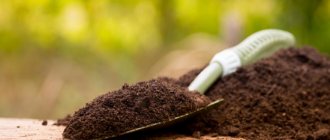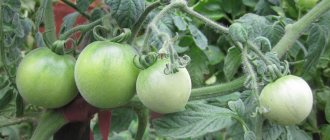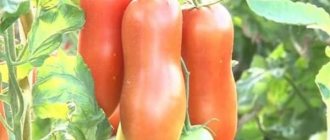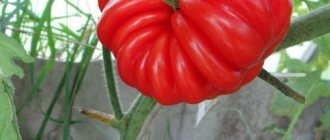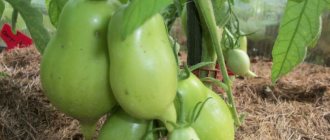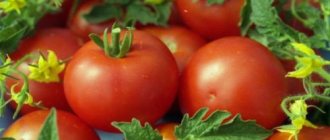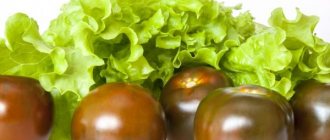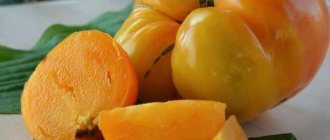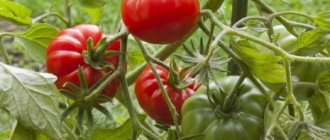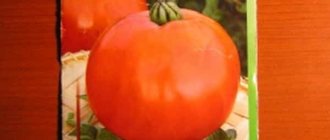Description of the tomato variety Black Baron
Black Baron tomatoes are a large-fruited variety with a dark color. The plant is indeterminate, forms a powerful tall bush, which requires staking and formation into 1-2 stems. The leaves are green, medium in size, high foliage. The inflorescence is simple, the first one is formed above the 7-8 leaf.
In the characteristics and description of the Black Baron tomato variety, the average ripening period is stated - 120 days pass from full germination to harvest.
The fruits of the variety are flat-round in shape, with medium ribbing at the stalk. When unripe, tomatoes are green with a green spot at the base. Ripe fruits acquire a brown-chocolate hue.
According to the internal structure, tomatoes of the Black Baron variety are multi-celled, having more than 6 nests. The weight of one fruit reaches 250 g. The skin is thin but durable, which makes tomatoes easy to store and transport.
Diseases and pests
There are a large number of varieties of diseases found in nightshades. Among the most dangerous are blossom end rot, Alternaria blight and the most common - late blight.
Important ! Overmoistening of the soil is the most common cause of disease.
The Black Baron variety is quite resistant to diseases and has good immunity, but preventive measures will not hurt at all. Let's consider the main causes and methods of preventing diseases.
Apical rot
The first sign of the disease is the appearance of watery spots on the tomatoes, which quickly grow and acquire a brown tint. The main causes of blossom end rot are temperature changes and lack of calcium in the soil. Excess nitrogen and high humidity also increase the likelihood of disease development.
For treatment, the leaves of the diseased plant are treated with a solution of calcium chloride.
Adding calcium as part of complex mineral fertilizers will be a good preventative measure.
Alternaria blight
Signs of the development of Alternaria include the appearance of small (up to 1 cm in diameter) dry gray spots. They appear first on the lower leaves. The disease then progresses and spreads to the entire plant.
A diseased bush will have to be treated with fungicides (for example, Kuproksat, Infinito).
Prevention of the disease consists of disinfecting the seeds and soil before planting, for example, with a strong solution of potassium permanganate.
Late blight
The causative agent of late blight is a fungus that first settles on the leaves in the form of grayish-brown spots and then consumes the entire plant.
When humidity is high, fluffy plaque grows. After spots appear on the fruit, the tomato rots. The main factors for the development of the disease are temperature changes, high humidity and rainy weather. On sunny days the disease is rare.
Late blight will be slowed down in the early stages only by fungicides (chemical: “Bordeaux liquid”, “Ridomil”; biological: “Fitosporin”, “Ecosil”) and the removal of affected leaves, and in the advanced stage - the entire plant.
As a preventive measure:
- regularly spray the bushes with fungicides (for example, biological) as soon as the temperature drops below +15 degrees;
- remove and burn diseased leaves;
- pick green fruits for ripening.
For disinfection, the removed fruits are kept for 1-2 minutes in water at a temperature of 60 degrees.
Pros and cons of the Black Baron tomato variety
Tomato Black Baron is a young variety of Russian selection. Tomatoes are distinguished by their high sugar content, dessert taste, and evenness of the fruit.
Other advantages of the variety:
- large size, regular round shape of the fruit;
- rich color of the peel and pulp;
- sweet, honey taste;
- high vitamin value;
- excellent yield;
- resistance to typical tomato diseases;
- good keeping quality and transportability.
The difficulties of the variety that a gardener may encounter include: the complex formation of the bush, as well as its spreading nature and the need to allocate enough space for the growth of the crop and the ripening of large fruits.
Origin of the variety and region of planting
Sometimes sources report that black-fruited tomato varieties are genetically modified, however, this is not the case. Back in Soviet times, black tomatoes were bred using the method of selection. Today the state register includes many of them.
The Black Baron variety was bred by breeders from Holland. It can be grown in all regions of Russia, including the Urals and Siberia. The variety tolerates minor temperature fluctuations. In cold regions, cultivation in greenhouses, as well as in systems with film cover, should be preferred. If climatic conditions are milder, normal planting in the ground is possible.
Optimal growing conditions
The plot for growing Black Baron tomatoes is prepared in advance. The culture grows well after cabbage, legumes or cucumbers. Sandy or loamy soils with neutral acidity are suitable for cultivation. Tomatoes will not develop in acidic soil, so lime or dolomite flour is added to it in the previous season.
For growing Black Baron tomatoes, it is best to build a warm, high bed, which consists of layers of organic matter and soil. A high bed warms up faster and remains warm, which is especially important for the root system of tomatoes. After all, when the roots come into contact with cold soil, the plants stop growing.
Advice! When growing tomatoes in open ground, it is important to install temporary shelters in case of a sudden cold snap.
The place for growing is chosen to be cultivated so that the adjacent area is also cleared of weeds. Tomato bushes should be ventilated, but without drafts or strong gusts of wind. Tall Black Baron tomatoes are planted in a direction from north to south so that the bushes receive enough sunlight.
Growing tricks: advice from experienced summer residents
Let's list a number of useful tips and tricks shared by experienced gardeners. With their help, it is easier to achieve a stable tomato harvest at your summer cottage.
Tips and Tricks:
- When removing stepsons, leave a small stump of 2-3 cm, then a new stepson will not grow from the sinus.
- To keep the humidity in the greenhouse lower, water the plant through a bottle buried next to the bush. This way the soil will be dry and crumbly, and moisture will flow directly to the roots.
- To prevent late blight in the greenhouse, place 2-4 open bottles of iodine. Its vapors effectively fight fungus.
- Before planting seedlings, disinfect the bed with a strong solution of potassium permanganate.
- If dark spots appear on the leaves and fruits, apply potassium fertilizers to increase the plant's immunity and solve the problem.
- If aphids appear on the leaves, wash them off with warm water and green soap.
- Slugs are afraid of ammonia. To solve this problem, spray the leaves and soil around the stem with an aqueous solution of alcohol.
- Flying insects do not like strong odors. They will be scared away by a tincture of chamomile, garlic or celandine.
Growing
The Black Baron tomato is grown through seedlings. Sowing begins in February-March, depending on the location of cultivation and the climatic characteristics of the region.
At the seedling stage, the crop is grown for about 60 days, adding to this a week for the emergence of seedlings.
The further growth and fruiting of the crop in open ground depends on the quality of the seedlings. Therefore, to obtain a high yield, only strong seedlings with thick stems, large leaves and a well-formed root system are replanted.
Growing seedlings
Single-sized seeds without damage are selected for sowing. To prevent diseases, seeds, including those collected independently, are disinfected by soaking in a fungicide solution.
The soil for cultivation is highly fertile, loose, without foreign inclusions. Before planting, it is disinfected, loosened and watered. When sowing in common containers, the seeds are placed in grooves at a distance of 2 cm from each other. The grooves are marked with a distance of 4-5 cm. When sowing in separate cassettes or cups, place 2 seeds in one hole in each container. In both cases, the seeds are buried no more than 1.5 cm. The crops are covered with fertile soil on top and sprayed with a fine sprayer.
Seeds germinate at a temperature of +25ºC. When seedlings appear, the plants are transferred to the brightest place. During the first 4 days, round-the-clock supplementary lighting is provided with special lamps. With a lack of lighting, the sprouts weaken and stretch, which further leads to slower growth and fruiting. At the same time, the temperature is lowered to +18ºC, which promotes the development of the root system.
After the first two true leaves appear, the plants are transplanted into containers with a large volume of soil.
Landing rules
Depending on the shape of the tomato, a planting scheme is chosen. The crop needs a sufficient feeding area, so for plants that are supposed to be grown in one stem, the distance between the bushes is kept at 60 cm, and for 2 stems - 80 cm.
Important! The seedlings are transferred to open ground by transshipment while preserving the earthen clod.
The hole is pre-watered abundantly. Bone meal is well suited as an organic fertilizer when planting Black Baron tomatoes. The additive gradually releases nutrients and does not deplete or oversaturate the soil with various elements.
Watering and fertilizing
During the growing period, large-fruited Black Baron tomatoes remove a lot of nutrients from the soil. Therefore, the crop needs 3-4 complex feedings during the growing season.
Watering for tomatoes requires uniform watering; drip watering is considered the best. Water the tomatoes with heated water without chlorine. The method of mulching the soil, which is covered with dry grass or black and white newspapers, helps to reduce watering and maintain looseness of the soil.
Pinching and tying
The Black Baron tomato variety is characterized by unlimited stem growth and large fruits, so the plant needs a garter. To prevent the plant from breaking under the weight of the fruit, it is necessary to tie up both the stems and the fruit clusters.
Advice! The stem is tied immediately after transplantation with a free loop to the stakes, as well as with twine and trellises.
During the growing season, the plant forms many side shoots - stepsons, which must be removed to prevent their growth. The shoot is broken out or cut off, leaving a stalk a few centimeters in size to stop re-growth.
Stepchildren are best removed in the morning so that the resulting wound has time to heal during the day. When using a garden tool, be sure to disinfect it and remove healthy plants first, and then those with signs of disease.
Formation
When forming a Black Baron tomato, all emerging stepsons are cut off into one stem. When forming into 2 stems, one strong stepson is left, which will later become the second stem. The remaining stepsons are removed completely. Also, during the growth period, the stem is gradually freed from the lower leaves, removing 1 piece at a time. in Week. It is especially important to remove leaves that come into contact with the soil to avoid fungal diseases.
At the end of the season, the growth of the stem is forcibly stopped by pinching the top above the last leaf. Thus, the plant will stop forming fruit clusters, and all its energy will be spent on ripening the fruits.
Protection from diseases and pests
The Black Baron tomato is resistant to many diseases. But under unfavorable weather conditions, bushes can be affected by various types of fungi. For prevention, spraying with “Fitosporin” is used, the soil is treated with “Trichodermin”.
Pests in the form of caterpillars and leaf beetles are collected manually, and they are also sprayed with Fitoverm on the leaf.
How to grow black tomatoes on your plot?
The agricultural technology of black tomato varieties is no different from growing red analogues. Like other tomatoes, the plant is provided with regular watering, weeding and fertilizer.
Features of growing and caring for the variety
The Black Baron variety has an indeterminate stem that is not limited in growth. The height of the plant reaches 150 centimeters or more. In this regard, the trunk must be secured to a support. To avoid breaking off, clusters with large fruits should also be tied up.
Preparation of seedlings
Seeds are planted for seedlings 50-60 days before the intended planting in a permanent place of growth. Seeds are sown for germination in a common box to a depth of no more than 1-1.5 centimeters. For faster germination, seed treatment with growth stimulants is useful.
After opening 1-2 true leaves, the sprouts are pricked, that is, transplanted into an individual container in which they grow until planted in the ground.
The optimal temperature for growing seedlings during the day is 20-25 degrees, at night - not lower than +18 degrees.
Water the seedlings after the top layer of soil has partially dried and do not allow moisture to stagnate at the roots. It is better to water in the morning, since waterlogged soil at night will cause hypothermia of the roots. Plants will get sick or even die.
Reference . For good seedling growth, phosphorus-potassium fertilizers are used.
Landing rules
At the age of 60-65 days, after stabilization of positive night temperatures, the seedlings are transplanted to a permanent place. No more than 3-4 plants are placed on one square meter. The distance between plants is at least 50 cm, row spacing is at least 60 cm.
Add humus to the planting hole and pour it well with not very cold water. After planting, the seedlings are not watered for a week. The moisture added during planting will be sufficient.
On a note . The deeper the seedlings are planted, the more additional roots are formed on its stem.
Rules of care
The main task of the gardener in caring for the Black Baron is to correctly form the bush. The variety is tall and must be grown on a support or tied to a trellis or greenhouse.
The bush is formed into one or two stems. To do this, leave the lower stepson on the main plant. Subsequently, this place must be covered with earth, then the stepson will form its own independent root system. All other stepchildren must be removed!
Important ! For healthy roots, the plant needs access to oxygen. To do this, the soil around the plant is kept loose and a hard crust is not allowed to form.
Do not forget to regularly remove weeds, because they take nutrients from the cultivated plant. In addition, weeding promotes loosening and additional aeration of the soil.
All large tomatoes require additional fertilizers, since the plant requires a lot of effort to grow large fruits. During the period of increasing green mass and growth of a young plant, tomato requires fertilizers with a high nitrogen content.
After the plant enters the flowering and fruiting period, the amount of nitrogen is reduced, giving preference to the potassium-phosphorus composition.
Watering
In order for the fruits to grow large, regular watering is important, but you should not allow the soil to become waterlogged. One or two deep waterings per week is sufficient.
It is better to water adult plants, like seedlings, early in the morning, so that the earthen ball has time to dry out a little during the day.
If tomatoes grow in a greenhouse, it must be ventilated, because, unlike cucumbers, tomatoes do not like too humid air. Constant moisture on the leaves will provoke the growth of fungi and putrefactive bacteria.
Characteristics of fruits and their purpose
The fruits of the Black Baron are flat-round, strongly ribbed, and resemble a pumpkin in shape. The color is interesting - bright brown. Unripe tomatoes have a dark green spot near the stalk; in ripe ones, it becomes chocolate-colored. The weight of one tomato is 150-250 g. There are not many of them in a brush - 3-5 pieces. The yield per square meter, according to modest calculations by the State Variety Commission, is 6.5 kg.
The fruits of the Black Baron are flat-rounded, strongly ribbed, shaped like a pumpkin
The tomatoes inside are multi-chambered, there is a lot of pulp, it is juicy, and there are few seeds. They argue about tastes, as always. Some gardeners find it sweet and honey-like, while others find it bland. In the State Register, the tasting rating is “good”, but did not reach “excellent”, but calls the Black Baron the sweetest among chokeberries.
The quality of the fruit depends on the structure of the soil, the fertilizers applied, and the number of sunny days, so Black Baron tomatoes on your site will have their own unique taste. Hence the purpose of the fruits is different. Of course, large tomatoes are not suitable for whole-fruit canning, but there are many other uses. Some people like the Black Baron more in sauces for meat, others - in sandwiches and pizza, and still others eat its fruits fresh, like fruit.
Tomato variety with the proud name “Baron F1”
The Baron tomato variety is an early-ripening hybrid.
From the day the seedlings are planted until the final ripening of the very first tomatoes, it usually takes from 90 to 100 days. The bushes are classified as determinate and standard. The formation of the first brush is completed after the sixth or seventh leaf. The foliage is quite high, the leaves have a bright green color. Once the tomatoes reach ripeness, they turn red. Their shape is round, the surface is smooth, and they are approximately the same in size. These are small fruits, the weight of most of them is from 150 to 200 g. Occasionally there are tomatoes weighing up to 230 g. The consistency of the pulp is quite dense. The taste is pleasant, sweet. Chambers - from four to six, dry matter concentration - from 5 to 6%. The crop can be stored for a long time and tolerates transportation well.
Advantages and disadvantages
Advantages of the Baron variety:
- High level of productivity.
- Versatility of use.
- Disease resistance.
- Resistance to temperature fluctuations.
- Easy care.
The variety has no tangible disadvantages, but a good harvest requires careful care.
Features of care
In general, this variety is unpretentious and resistant to tomato diseases, but it is necessary to follow some rules associated with its cultivation if you want to get the maximum yield. The following measures are required:
- Watering.
- Loosening the soil.
- Application of fertilizing.
During the growth period, you need to carefully loosen the soil and water the bushes. In addition, it is necessary to fertilize the soil with fertilizers that have both liquid and solid consistency. Compost and growth stimulants are optimal for this purpose. During periods of fog, it is necessary to protect bushes grown in open ground from late blight. It is unacceptable for the leaves to touch the soil.
General information
Hybrid Black Baron f1 is famous for its high yield. Caring gardeners collect more than 3 kg of large fruits from each plant. The bushes grow throughout the warm season, so the variety must be regularly pinched and the stems tied to strong supports. To get the maximum yield of good fruits, you should leave only two stems on one bush.
Raspberry variety Peresvet: description, photos, reviews, secrets of planting and care
The first inflorescence is formed above the 7th or 8th leaf. By the way, the foliage of the Black Baron is of an unusual emerald color.
According to the description, the color of the fruit is chocolate or dark burgundy. They are round in shape, and slightly ribbed near the stalk - see photo.
Vitamin-rich Baron tomatoes are delicious fresh. You can also preserve them, prepare all kinds of seasonings from them, or make juice.
A little about the origin of the hybrid
Among inexperienced gardeners there is an opinion that dark tomatoes are genetically modified. Actually this is not true. In our country, such tomatoes were grown when nothing was known about genetic engineering.
Dark tomatoes were bred by amateur breeders, so these wonderful vegetables were rare in Soviet times. They were not particularly popular due to the lack of proper information. Today, the State Register includes a number of dark varieties of tomatoes.
As for the Black Baron specifically, he was bred by Dutch breeders. Fortunately, this hybrid has taken root well in most regions of our country, including the Urals and Siberia. Reviews from gardeners living there confirm this. In colder latitudes, these tomatoes are grown in greenhouses.
Best reviews from our readers
- Svetlana
City: Vladimir regionWhere grown: Greenhouse
Planted Black Baron in 2021. I really liked the variety, tasty, aromatic, enough fruit to eat. This tomato should just be eaten fresh, it’s very tasty. It begins to bear fruit quite early, one of the first, bears fruit until the end of the season, and is also resistant to diseases. I recommend!!!
- Tatiana
City: St. PetersburgManufacturer: Johnsons
Where grown: Greenhouse
A strange variety for me. Last year, when the entire Leningrad region was flooded with rain, Black Baron was one of the few varieties that pleased us with the harvest. Not to say that there were a lot of tomatoes, but there were some. I planted it again this year. Germination, like all seeds from Johnson's, is excellent, but the plant itself... The first clusters tied perfectly, and the second and third ones were at a distance of almost 50 cm from each other. As a result, there are three brushes in total hanging on a bush approximately 160 cm high. Some kind of empty plant. The tomatoes themselves are tasty, but I won’t plant them next year; there are more interesting varieties.
- Galina
City: LyubertsyManufacturer: Johnson
Where grown: Greenhouse
Wonderful productive variety! I sowed seeds (12 pieces) without even getting them wet, besides this variety there were 5 more. The germination rate of the Black Baron was 100%. Formed into 2 stems, about 5 kg per plant. The fruits are sweet, there are not many seeds, and the color is not very brown. It is advisable to process picked tomatoes; they do not last long. I treated it to relatives and friends, everyone really liked it. I recommend it.
- Tatiana
City: BelgorodManufacturer: Johnson
Where grown: Greenhouse
Wonderful variety! The family really liked the taste. It bears fruit from late June to mid-November, despite my very modest care. This year I sowed my seeds and have already taken off. I hope it won’t let you down. I wish everyone good luck
Advantages and disadvantages
Among the main advantages of the variety:
- high taste of tomatoes;
- the fruits are well stored;
- it is possible to use fruits in cooking, canning;
- resistance to diseases.
The disadvantages include:
- the need for careful formation of the bush;
- heavy branches need support;
- the plant requires abundant feeding.
Characteristics
Argonaut F1 is a relatively young variety. It was eaten by breeders of the Gardens of Russia company in 2011, and it was included in the State Register in 2015.
The tomato grows well in the middle zone, the Moscow region and the Non-Black Earth zone. Even in conditions with a harsh climate (the middle part of the Urals and the northern regions of Siberia and the Far East), Argonaut manages to bear high-quality fruit. In open ground, the yield of the hybrid is 3-4 kg per plant. When grown under film covers, it increases slightly - up to 4.5 kg per bush.
You can compare the yield of Argonaut tomatoes with others below:
| Variety name | Productivity |
| Argonaut | 3-4 kg per bush |
| Gulliver | 7 kg per bush |
| Pink Lady | 25 kg per square meter |
| Fat Jack | 5-6 kg per bush |
| Doll | 8-9 kg per square meter |
| Lazy | 15 kg per square meter |
| Black bunch | 6 kg per bush |
| Rocket | 6.5 kg per square meter |
| Brown sugar | 6-7 kg per square meter |
| King of Kings | 5 kg per bush |
Read on our website: how to get good tomato yields in open ground and winter greenhouses.
What subtleties of growing early varieties of tomatoes should every gardener know? Which tomato varieties are resistant to most diseases and have high yields?
The Argonaut hybrid has many advantages. The most valuable thing, according to gardeners, is high yield and early fruiting. Among summer residents, the variety received the nickname “supertomato” for its disease resistance and stable fruiting.
Among the shortcomings, reviews only mention the need to tie plants to stakes, since, despite the small height, the bush tends to “fall over.” The main feature of the variety is the uniformity of fruits obtained from one plant. Their size, color and shape completely match each other.
All this allows you to grow tomatoes not only for your own consumption, but also for sale.
Features of agricultural technology of black-fruited tomatoes
Growing black varieties of tomatoes is not difficult if you become more familiar with agricultural technology. Dark-fruited cultivars are most often grown by seedlings: sowing is organized taking into account the ripening period of the cultivar, usually 50–60 days before planting in the ground. Grown-up seedlings of black tomatoes require no more attention than classic red-fruited ones, regardless of growing conditions.
- Black tomatoes are light-loving; they are planted in open sunny areas. If greenhouse forcing is intended, it is advisable not to shade dark-fruited cultivars.
- The optimal amount of moisture is the key to juicy and aromatic fruits of any color. One fruiting tomato bush needs 4–5 liters of water, tall, highly branched varieties require more - up to 8–10 liters.
- Periodically - once every 14 days - it is necessary to apply mineral and organic fertilizers at the root: for example, Epin, Borofoska, Kemira are suitable, alternate with liquid fertilizer based on mullein. Before fruiting, black tomatoes are fed with potassium fertilizers, then the “blackies” will be truly sweet.
- Black-fruited tomatoes, like other varieties of tomatoes, are usually pinched. If you ignore this procedure, the yield is significantly reduced, the plant actively grows foliage and shoots, and fruit ripening slows down.
- Tall varieties need staking.
- Regular loosening and weed control in tomato beds is no less important than nutrition and watering.
- Mulching tomato bushes is an excellent way to maintain optimal soil moisture and at the same time control weeds.
- Prevention of fungal and bacterial diseases in beds with black tomatoes is mandatory. Such drugs as Fitosporin, Fitoverm, as well as folk recipes (serum with iodine, garlic infusion, etc.) will come to the aid of gardeners.
Video: review of black tomatoes
The assortment of dark-fruited tomatoes offers gardeners a variety of varieties - cherry, large-fruited, salad, and even for pickling. Black tomatoes do not differ in agricultural technology from their classic red-skinned counterparts, but their flesh is much sweeter. To find out which dark-fruited tomato is the most delicious, you need to not only taste it, but also grow it yourself. What is made with your own hands is three times more valuable, and therefore tastier. Go for it!
